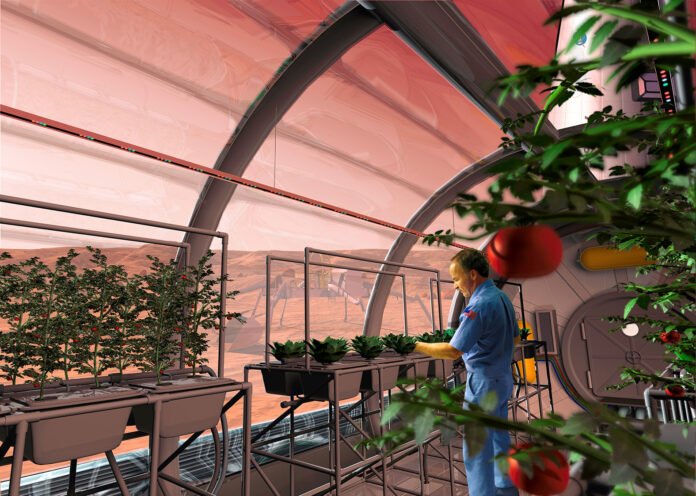How do you feed a crew of six astronauts on an 80-million-mile, three-year mission to Mars, where there are no grocery stores, gardens, farms, fertile soil or resupply vehicle?
NASA space food scientists at Johnson Space Center are working harder than ever to find the answer to this question. They are currently developing an Advanced Food System (AFS) that will provide future crews traveling to the moon and Mars with safe, nutritious and appetizing food while minimizing volume, mass and waste.
Shelf life
The AFS approach includes extending the shelf life of a stored food system from 18 months (currently the typical shelf life of space station-stored foods) to up to five years, while maintaining a variety of great-tasting foods. With the need for longer shelf life, the menu will move more towards thermostabilized foods, which maintain their quality longer than current freeze-dried foods.
The food will be contained in airtight, lightweight packaging to ensure freshness. It will then be stored in the crew vehicle to maximize its shelf life, while remaining accessible to the crew.
Space gardening
Ten pick-and-eat vegetable crops have been identified for possible growth in transit on long-duration missions: lettuce, spinach, carrots, tomatoes, green onions, radishes, bell peppers, strawberries, fresh herbs and cabbages.
These crops will provide the crew with added nutrition and variety. Veggies, unlike prepackaged foods, will add bright colors, crisp textures and fresh aromas to the crew’s menu.
When the crew arrives at its destination, the lack of fertile soil on the lunar and martian surfaces will make stepping into the backyard to grow a garden impossible. Instead, astronauts will build hydroponic growth labs, where pick-and-eat vegetables, as well as white and sweet potatoes, soybeans, wheat, rice, peanuts and dried beans, can be grown. The latter crops would require processing to convert raw goods, such as wheat, into foods like bread and pasta.
To make food processing a reality, specialized equipment will be needed for each crop grown. The martian food processing equipment will be much smaller than standardized equipment and will use minimal water, power and crew time.
If harvested crops cannot be grown, bulk ingredients such as packaged soybeans or wheat berries can be sent with the crew on the mission to be used later.
What’s cooking in the kitchen?
Once on the moon or martian surface, each of the crew’s meals will be prepared in the habitat galley using fresh vegetables, ingredients processed from the crops and other stored items. The galley equipment will be similar to commercially available gourmet kitchen appliances, but modified for use in partial gravity.
A typical martian dinner might include dishes such as spinach and tomato crouton salad, wheat pasta with tomato sauce and a chocolate peanut butter soymilk shake.
Martian dining for the body and mind
The longer the mission, the more important it is to have a quality food system that is nutritious, safe and tasty. In addition to the crew’s physical health, psychosocial health has been identified as an important factor during space missions. If crewmembers are under stress, their health and performance can suffer. Anecdotal reports state that healthier and tastier foods will decrease the stress often experienced by the crew. This suggests that taste, menu variety and an array of textures, colors and flavors can contribute to the psychosocial well being of the crew.
Next steps
The main challenges that lie ahead for NASA’s space food scientists are to enhance packaging and shelf life for stored food. Advances in the design, fabrication and testing of miniaturized processing equipment are also necessary. The effects of radiation on the quality of stored foods and the functionality of stored crops are two other major challenges. Finally, researchers must determine how the AFS will influence many of the crews’ life-support systems such as air and water recovery, solid waste processing, thermal management and biomass production.
Discover more from SNAP TASTE
Subscribe to get the latest posts to your email.


